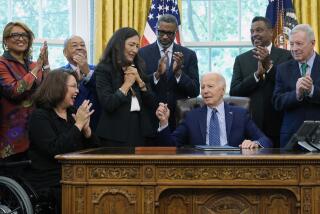New Memorial Pays Tribute to Civil War’s Black Soldiers
- Share via
Janice Lorenz, of Lanham, Md., never spent time studying her family tree. Then she heard a lecture a year ago on the suffering of the forgotten black soldiers of the Civil War and efforts to build a national memorial to them in the District of Columbia. “I made a connection,” she said. “Although I knew we had Civil War soldiers in the family, we had never stopped to think of their sacrifice.”
Life for Lorenz and her husband, Blake, has rapidly expanded to include research at the National Archives, weekend trips to military cemeteries and visits to out-of-state relatives to look through family records and photos.
Their work has rewarded them with a dining room table full of military discharge and pension records, wedding certificates and family portraits. Janice Lorenz’s great-grandfathers on her mother’s and father’s sides not only fought in several battles but survived to marry and rear families. Their names will be on the $2-million memorial, which will be the first national memorial dedicated to black servicemen who fought for the Union and their white officers.
When construction bids came in $400,000 higher than expected, D.C. Council Member Frank Smith Jr. pushed the groundbreaking back from last year to this month.
There was also a design crisis. Smith had asked the National Park Service employees responsible for creating a master computer list for all Civil War servicemen to compile the black soldiers’ names first. John Peterson, project manager for the Civil War Soldiers and Sailors System, said they were glad to help. But when Smith was given the list, he saw 56,000 more names than the 185,000 anticipated.
Smith said they didn’t want to add plaques for design reasons and didn’t want to have the names printed too small to be read.
Peterson said they considered several options to reduce the list without compromising the official military records.
They knew the list was much greater than the actual number of veterans because of duplications and errors. Then they found more than 800 men named George Washington.
“Washington was held in high regard by Northerners and Southerners and blacks and whites,” said Edward Smith, an American University professor and Civil War authority.
Peterson said they reduced to one name any multiple George Washingtons in a regiment; each such pruning will be noted. Then they went through the 138 regiments of United States Colored Troops as well as state regiments looking for duplicate records and for those who served in more than one regiment.
“Although that number still exceeds the number of people who actually fought, we bent over backward not to eliminate any names where there was a question,” Peterson said.
Frank Smith said he has “shoehorned” in the extra names.
Peterson said the names will appear on the memorial exactly as they were written in the early 1900s, when more than 5 million file cards were transcribed from original military records. An error made by a clerk then will not be corrected. If a man used an alias--and many did for protection from slave masters--the alias appearing in the records is used.
That issue has become emotional for descendants who want the right name on the memorial, Peterson said. “The stories are poignant, and I feel sorry for them. . . . But we have to answer that we can’t make changes on a case-by-case basis. We have to rely on the historical consistency reflected in the National Archives records.”
Janice Lorenz found that the records for her great-grandfathers Whitfield Ross and James Kelly were incorrect. Whitfield will appear as Whitefield and Kelly as William Turner, the alias he used. “We begged and pleaded with them to make the names right, but they just won’t do it,” Lorenz said.
However, the Lorenzes say what is most important is that long-dead ancestors are no longer just names. “The odds were against them, and they survived,” Janice Lorenz said. “And that is what is meaningful about our research. They are real heroes and real people now.”
More to Read
Sign up for Essential California
The most important California stories and recommendations in your inbox every morning.
You may occasionally receive promotional content from the Los Angeles Times.













